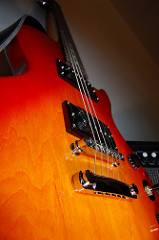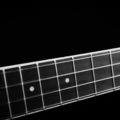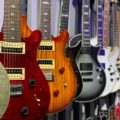The Guitar Neck
The guitar neck is a vital component of the instrument. It consists of the fretboard and the truss rod, which helps maintain the neck’s straightness. The fretboard can be a solid piece or have inlays for the frets, typically made of rosewood, ebony, or maple. The truss rod, located inside the neck, can be adjusted to prevent bowing or warping. At the headstock, you’ll find the tuning setup with machine heads and adjusting pegs, as well as string guides to keep the strings in place. The nut, made from materials like ivory or bone, sits at the top of the neck and holds the strings.
The Guitar Body Schecter Guitars - Schecter Guitars: High-End Quality and Rarity Schecter guitars are currently known as high-end quality instruments that are sleek and beautiful, with a price to match. Best recognized for their custom-made guitars, which can only be purchased through authorized dealers with restrictions, Schecter Guitars have gained a reputation as a rare breed – and they are…
The guitar body is usually a solid piece of wood that is routed to accommodate the guitar components. The neck can either be bolted onto the body or glued, depending on the guitar kit. Neck-through models have a neck that runs the length of the guitar and is also glued to the body.
The Bridge
The bridge is located on the backside of the guitar, behind the back pickup, and is where the strings are attached. It is typically suspended on the back of the guitar body, with springs counteracting the tension of the strings. Bridges can be classified as tremolo or non-tremolo variations.
Hardware
The hardware of the guitar is where the sound is produced. Pickups are a crucial part of the hardware, and they come in various types, such as single coil or humbucker. Single coil pickups are known for their clear bluesy tones, while humbuckers are commonly used for rock and heavier tones. There are also stacked humbucker pickups, active pickups, and more. Selector switches allow you to choose which pickup is in use, with 3 or 5-way options available for different combinations. Volume and tone potentiometers, commonly referred to as pots, provide control over the guitar’s volume and tone. Upgrading these components can offer better precision and control over your tone. Finally, there is the input jack where you plug in the instrument cable. While many guitar kits come pre-wired, you may consider wiring the components yourself once you have a better understanding of guitar hardware. This allows for more customization and control over your tone. When all these pieces come together, you have a complete guitar ready to be played.
Manuel Marino is a seasoned Senior Producer, Music Composer, and Artist with over a decade of experience. He specializes in branded entertainment across various mediums, including video games, films, and advertising campaigns. With 20+ years as a game music composer, Manuel has worked on numerous platforms, creating diverse orchestral soundtracks. HIRE ME


 Manuel is a passionate, driven, and techsavvy AV technician,
Manuel is a passionate, driven, and techsavvy AV technician, 










